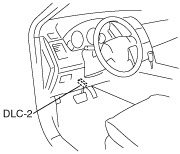 |
AUTOMATIC TRANSAXLE FLUID (ATF) INSPECTION [AW6AX-EL]
id0517j6800500
Automatic Transaxle Fluid (ATF) Condition Inspection
1. Inspect the ATF for the following to determine whether the transaxle should be disassembled.
ATF Condition
|
Condition |
Possible cause |
||
|---|---|---|---|
|
Clear dark red
|
Normal
|
—
|
|
|
Light red (pink)
|
Contaminated with water
|
• Damaged oil cooler
• Poor filler tube installation:
Problem could occur to parts inside the transaxle due to water contamination.
If necessary, replace the transaxle.
|
|
|
Reddish brown
|
Has burnt smell and metal particles are found
|
Deteriorated ATF
|
Defective powertrain components inside the transaxle:
Particles cause wide range of problems by clogging the oil pipe, control valve body and oil cooler.
• A large amount of metal particles are found.
If necessary, replace the transaxle.
• Flush the system due to possible clogging of the oil pipe or oil cooler.
|
|
Has no burnt smell
|
Normal
|
• Discoloration by oxidation
|
|
Automatic Transaxle Fluid (ATF) Level Inspection
1. Place the vehicle on level ground.
2. Apply the parking brake and position wheel chocks securely to prevent the vehicle from rolling.
3. Connect the M-MDS to the DLC-2.
L.H.D.
ac9uuw00002033
|
R.H.D.
ac9wzw00000007
|
4. Monitor the ATF temperature using the M-MDS.
5. Warm up the engine until the ATF reaches 60—70 °C {140—158 °F}.
6. Shift the selector lever and pause momentarily in each range (P—D) while depressing the brake pedal.
7. Shift the selector lever to P position.
8. Verify that the ATF level is in the HOT range (65 °C {149 °F}) while the engine is idling.
ac9uuw00001665
|